In the last few months, I noticed a notable increase in my ability to control firearms, namely shotguns and handguns. At first, I thought I was just seeing an increase due to practice, but why now? I realized that over the last few months, my grip strength had improved significantly.
I had started Judo, and Judo is big on grip strength. Every practice included grip-strength exercises that had my forearms screaming by the end. Then, the actual art of Judo has lots of grabbing, gripping, pulling, and pushing, all of which added to my overall strength.

My hands were calloused, but much stronger. I could feel it during heavy workouts, and I no longer struggled to maintain a grip during exercises like the deadlift. It got me thinking: how much does grip factor into controlling a handgun?
Obviously, we need some grip strength to handle any firearm. If not, it’ll pop out of our hands. Those idiots who hand Magnum revolvers to new shooters and post the results are evidence of that.
With that in mind, how much does grip contribute to shooting ability? From a personal perspective, it seems like I shoot a lot better now, but that’s anecdotal at best. What does science say?
Grip Strength and Guns — What The Science Says
Believe it or not, a few studies have been conducted on grip strength and guns. Donald Rodd, Ph.D., conducted a study of law enforcement recruits at the Indiana Law Enforcement Academy.
He studied 141 recruits aged 21 to 37, all of whom were right-handed. Grip was measured using a Smedley III hand dynamometer when the recruits entered the academy, the day before initial firearms training, and after completing the qualification.

Throughout the academy, the recruits fired 1,600 rounds total over two weeks.
The results showed there was a positive association between handgrip strength and handgun qualifying score. Those with higher handgrip results scored higher during qualification. However, some individuals with the highest handgrip strength demonstrated lower qualifying scores.
According to the study, a strength threshold may exist in which handgun accuracy suffers. The general conclusion is that better grip strength correlates with better accuracy, but only up to a point, and that further study is needed.

Anne G. Copay and Michael T. Charles published “Influence of Grip Strength on Handgun Marksmanship in Basic Law Enforcement Training.” In this study, they split a recruit class in two. Half of the class received Grip Master training devices.
While both groups improved their scores after firearms training, the Gripmaster group showed better performance than the group that did not conduct grip strength training.
Grip Strength and Common Sense
Some factors of grip strength and shooting seem like common sense to me. In the past, a phenomenon called limp-wristing was known to create malfunctions in semi-automatic pistols. Limp-wristing is often from a weak grip.
A firm grip is a must. Most people limp-wristing had enough grip to prevent it, but weren’t gripping the gun firmly enough. However, a firm grip is easier to establish and maintain when you have adequate grip strength.

We can also dig into firearm retention. It’s easier to prevent someone from taking your gun if you’re stronger than they are. Grip strength will play a minor role in preventing your firearm from being taken from you.
In a self-defense scenario, you’re not likely to fire enough rounds to create fatigue. In training, especially in an 8-hour class, it’s easy to get tired and to be less consistent. More grip strength aids in being more consistent during training, which leads to greater training value.
When we get into pulling triggers, I believe better grip strength offers some advantages that can’t be ignored. Grip strength, along with properly trained technique, will help you resist recoil and minimize muzzle flip. In particular, the push/pull recoil mitigation technique relies on good grip strength to tame the mighty repeating claymore.

Most high-level shooters I’ve listened to emphasize a firm grip on the gun, not a crushing grip. Too tight a grip will cause the gun to shake, at least in my experience. A firm grip doesn’t require you to be a gym beast, but it does require a certain amount of grip strength to maintain.
Improving Grip Strength
One way to improve your grip strength is to start Judo, but that seems like a bit much for the everyday person.
Luckily, there are plenty of techniques you can do to start improving your grip strength. If you already work out regularly with free weights, your grip strength is already sufficient to manage a gun just fine. However, if you have a spare 10 minutes every day to get better, there are a few things you can do.
First, there is the no-equipment route. Hold your arms straight in front of you with your wrists loose and your hands dangling down limply. Then, raise your hands upward into a clenched fist. Repeat until your arms are burning.

If you want a pocketable piece of equipment, the Prohands Gripmaster is a simple tool that isolates each finger and provides full grip training. It’s affordable and something you can do on your morning commute or during a break at the office.
If you have a dedicated workout time, you can wrap a towel around your weights to increase their grip circumference. There are also dedicated wraps called Fat Gripz, which do the same thing in a more refined package. Do some farmer’s carries with a thick grip weight, and you’ll feel it.

You can also do grip-isolating exercises, such as wrist curls, to improve forearm strength. There are tons of ways to do it, and most are simple and effective.
Getting a Grip
Grip strength is likely a minor factor when compared to proper grip and technique, but if we are chasing increased performance, it’s an off-the-range shooting skill worth building. It takes very little time and effort, and grip strength offers additional benefits— shooting—worth considering.









